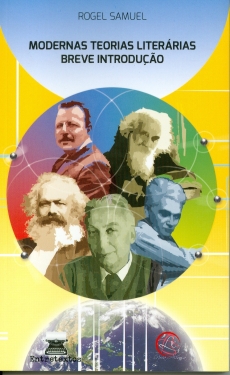Obituário do heróico cientista Grover Krantz, de Salt Lake City, Utah
O corajoso Dr. Grover S. Krantz, um cientista da Washington State University, falecido em 2002, estudou o misterioso sasquatch, colocando heroicamente em risco sua carreira de professor e pesquisador.

" 'Abaporu' (1928), de Tarsila do Amaral" [Brazilian painter, b. 1886 in Capivari (São Paulo state) - d. 1973 in the city of São Paulo (São Paulo state), http://en.wikipedia.org/wiki/Tarsila_do_Amaral; Abaporu, "(...) The composition: one man, the sun and a cactus – inspired Oswald de Andrade to write the Anthropophagite Manifesto and consequently create Anthropophagic Movement, intended to 'swallow' European culture and turn it into something culturally very Brazilian, http://en.wikipedia.org/wiki/Abaporu] "(Imagem: arqa.com)" (http://www.minimomultiplo.com/index.php?page=64)
O PÉ GRANDE É MACACO (grande primata), NÃO É HOMO SAPIENS, NEM 'ELO PERDIDO', mas não é "mera" lenda, de acordo com Krantz:
"(...) Grover foi a primeira pessoa a estabelecer, a partir do estudo de moldes [casts] e pegadas [tracks, como no original em inglês, ou footprints, impressões de pés], que os fabricantes das pegadas [footprints] grandes têm uma estrutura de pé que significativamente difere da dos seres humanos. (...)". (Dr. John Green, amigo de longa data do Dr. Krantz e seu colega, em artigo escrito após o falecimento do grande primatoantropologista, artigo abaixo transcrito na íntegra.)
"(...) Com base nos fósseis encontrados - inicialmente molares de aproximadamente 2,5 centímetros (recuperados em lojas tradicionais de medicina chinesa), sabe-se que o Gigantopithecus tinha mais ou menos 3 metros de altura e pesava algo entre 300 e 500 Kg - sendo de duas a três vezes maior do que os atuais gorilas. (...)". (http://pt.wikipedia.org/wiki/Gigantopithecus)
13.11.2009 - Loren Coleman escreveu o seguinte obituário de Grover Sanders Krantz, um cientista rigoroso que não temeu estudar não apenas os gigantopithecus asiáticos, mas, também, o grande ser das Montanhas Rochosas, conhecido em idioma português como pé grande [ http://pessoas.hsw.uol.com.br/pe-grande.htm ; http://mortesubita.org/monstruario/bestiario/pe-grande/view ], o " yeti" ("abominável homem das neves") do sudoeste canadense e noroeste estadunidense. [O ÚLTIMO TEXTO ABAIXO TRANSCRITO ESTÁ EM LÍNGUA PORTUGUESA.]
|
Grover S. Krantz (1931-2002)

|
| |
|
Grover S. Krantz, an anthropologist who was never afraid to take the unpopular academic position that the primates called Sasquatch actually exist, died peacefully, on the morning February 14, 2002, in his Port Angeles, Washington home.
As the modern era's first academically-affiliated physical anthropologist to actively involve himself in Bigfoot/Sasquatch research, Dr. Krantz was one of the most quoted authorities on the status of the controversy. He began his research in 1963, and it took him from the analysis of the Patterson-Gimlin film of 1967, to an examination of the Skookum body cast of 2000. He wrote or edited several papers on the Sasquatch, of a formal scholarly nature (published in Northwest Anthropological Research Notes) and four books, The Scientist Looks at the Sasquatch (Moscow: University Press of Idaho, 1977, with anthropologist Roderick Sprague), The Scientist Looks at the Sasquatch II (Moscow: University Press of Idaho, 1979, with Roderick Sprague), The Sasquatch and Other Unknown Hominoids (Calgary: Western Publishing, 1984, with archaeologist Vladimir Markotic) and Big Footprints (Boulder: Johnson, 1992), revised as Bigfoot Sasquatch Evidence (Seattle: Hancock House, 1999). Dr. Krantz, as an outspoken academic, was a focus of the 1999 documentary Sasquatch Odyssey (director Peter von Puttkamer), which also profiled the late Rene Dahinden, John Green, and Peter Byrne. While these men did not often get along, they formed the "Four Horseman of Sasquatchery," the foundation of thought on these unknown hominoids in the Pacific Northwest from the 1960s onward.
Dr. Krantz was the primary North American spokesperson for the stance of killing a Bigfoot to prove they exist. He will most be remembered, however, as the foremost proponent of the theory that the survival of the giant ape Gigantopithecus, recently thought to be extinct, is the source of modern Sasquatch reports. He created the first reconstructions of the full skulls of Gigantopithecus and Meganthropus, as well as restoring various elements of understudied Homo erectus finds. During the late 1990s, Dr. Krantz became one of the major supporters, in academia and in court, for the preservation for study of the disputed Kennewick skull which he theorized might have a non-Native American origin.
Grover S. Krantz, born in 1931, in Salt Lake City, grew up in Rockford, Illinois, then moved with his family to Utah when he was ten. Krantz went on to study at the Universities of Utah, California (B.A. 1955, M. A. 1958) and Minnesota (Ph. D. 1971), with a concentration in human evolution. He was a professor at Washington State University since 1968, until his retirement in the 1990s. During his retirement, he still taught one anthropology course per year, beamed via television back to Pullman, from his home in the Olympic Peninsula. He continued his research until his illness allowed him to do no more work.
Dr. Krantz was a physical anthropologist whose teaching and research had covered all aspects of human evolution, primarily of skeletal traits, but also the evolution of the human capacity for culture. He had visited many museums in Europe, China and Java to study original fossils and to make casts of some (Java) for distribution to other scientists. He had accumulated a major collection of such casts, including his own reconstructions of many of them. Dr. Krantz's major non-Sasquatch anthropological works were Climatic Races and Descent Groups (1980), The Antiquity of Race (1981, 1994, 1998), The Process of Human Evolution (1982, 1995), and Geographical Development of European Languages (1988). Other publications included original work on such topics as Neanderthal winter survival, precision gripping of stone tools, language origins, mastoid function, tooth wear, mammal extinctions, sea-level changes, nonmigrations of hunting peoples, Neanderthal taxonomy, Ramapithecus as a female form, and pelvic evolution - all illustrated by the author.
Dr. Krantz died from pancreatic cancer. The always active Grover Krantz went into decline soon after he told cryptozoologist Loren Coleman on December 6, 2001: "Medicine men differ as to whether I have months or years to live." Such reflected the final uphill battle that Grover faced in a life of challenges. Diane Horton, his wife, was with him constantly, to the end.
Grover S. Krantz's candid assessments in hominology and towering vision in cryptozoology will be missed by the many people who have followed his work for decades, but his thoughts and concepts will remain to continue educating generations to come.
According to Diane Horton: "There will be no local service. Grover's body will be sent to the 'Body Farm' at the University of Tennessee and then his skeleton will be sent to the Smithsonian Institution along with most of his academic materials. As he helped students in life, his skeleton and materials will be available to serious scholars in death. In lieu of flowers, people can make memorial donations to Hospice of Clallam County, P.O. Box 2014, Port Angeles, WA 98362."
------------
'I fully accept the Patterson film,' Grover Krantz was quoted in 1999. Bigfoot's loping gait is 'consistent with a 500-pound biped,' he said. 'I've attempted to imitate it, and I really can't do it worth a damn.' ". (http://lorencoleman.com/grover_krantz_obituary.html)
-------------
|
Sobre o autor do obituário: "Cryptozoologist Loren Coleman is the author of twenty books, including Bigfoot! The True Story of Apes in America (Paraview Pocket, 2003). His website is www.lorencoleman.com". (http://lorencoleman.com/grover_krantz_obituary.html) |
===
John W. Green escreveu sobre Grover S. Krantz [a repetição do texto acima transcrito é proposital, uma vez que o Dr. J. W. Green, com conhecimento de causa, fez pequenas correções no relevante obituário de autoria de Loren Coleman - "outro antigo pesquisador" -, como ele mesmo (Dr. Green) declarou: "(...) The following more detailed information is borrowed, with permission and minor alterations, from an obituary posted on the internet by another long-time researcher, Loren Coleman" (...)]
 Grover S. Krantz
Grover S. Krantz
1931 - 2002
by John W. Green
"In the fall of 2000, when the Skookum cast was shown to a group of sasquatch researchers who had not been present when it was found, four out of the five newcomers were scientists with doctors' degrees. It is hard for old-timers to remember, and probably even harder for others to appreciate, how different things were 30 years before.
That is how long ago that Grover Krantz, then an associate professor of anthropology at Washington State University, risked his career, and the PhD he did not yet have, by advocating that evidence for the existence of a huge bipedal primate in North America deserved scientific study.
Then, and for years afterward, he was the only member of the academic community prepared to face the ridicule of his peers and jeopardize future prospects for tenure and promotion by insisting publicly that 'Bigfoot' tracks are made by real animals, and that the people who tell of seeing enormous, bipedal apes should be taken seriously.
His courageous example did much to stimulate participation in the study by both scientists and laymen, and for that he deserves the respect and gratitude of everyone involved, and he did a great deal more than that. While a lot of his extensive research and published work paralleled what others were also doing, he brought to it a set of skills and qualifications that no on else had. In addition some of his contributions were entirely unique.
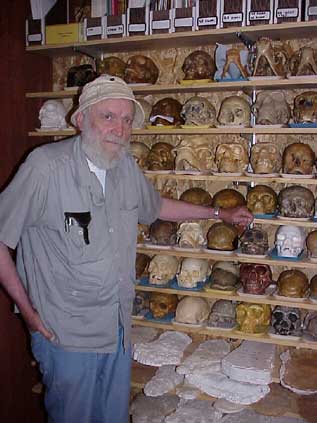 |
Grover stands before his impressive collection at his home.
Photo by Richard Noll. |
Grover was the first person to establish, from the study of casts and tracks, that the makers of the big footprints have a foot structure differing significantly from that of humans.
He was also the first to note and study the patterns of skin ridges that show up on a few of the casts, establishing that footprints laid down far apart in both space and time show patterns that are the same, and that differ from those of humans or any other animals.
While not the first to suggest that sasquatch might be Gigantopithecus, not extinct after all, he was the first to point out that the shape of their fossil jaws indicates that those giant apes probably walked upright. And he had the skill and knowledge to do an authoritative reconstruction, based on the largest jawbone, of a matching skull that demonstrates strikingly that Gigantopithecus was as huge as sasquatch are reported to be.
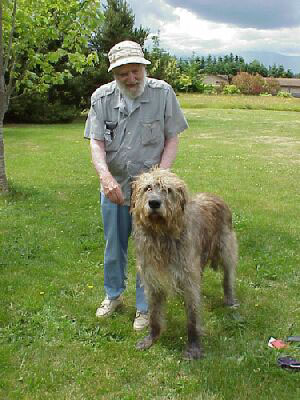 |
Grover enjoys time with another of his favorite animals... his Irish Wolfhound, Ralph.
Photo by Richard Noll. |
He showed his courage also in enduring the abuse to which he was subjected for maintaining the increasingly unpopular opinion that it is justifiable to kill one of the animals, because nothing short of physical remains will convince science of the existence of the species. While far from being alone in that position, he was almost alone in being prepared to defend it in public.
Lost in the uproar was the fact that he spent a lot of money and effort trying to locate remains from a natural death, and also twice tried to prove himself wrong, with major attempts to obtain scientific acceptance based on the tracks, and then on the skin ridges.
It is a matter for great regret not only that he did not live to see a successful conclusion to his work but also, for the rest of us, that his work was interrupted when he still had so much more to contribute.
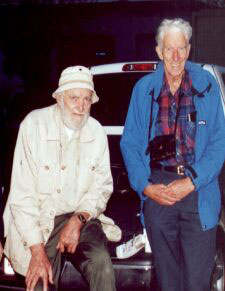 |
Grover with long-time friend and colleague John Green.
Photo by Jeffrey Lemley. |
The following more detailed information is borrowed, with permission and minor alterations, from an obituary posted on the internet by another long-time researcher, Loren Coleman.
Grover S. Krantz, an anthropologist who was never afraid to take the unpopular academic position that the primates called Sasquatch actually exist, died peacefully, on the morning of February 14, 2002, in his Port Angeles, Washington home.
As the modern era's first academically-affiliated physical anthropologist to actively involve himself in Bigfoot/Sasquatch research, Dr. Krantz was one of the most quoted authorities on the status of the controversy. He began his research in 1963, and it took him from the analysis of the Patterson-Gimlin film of 1967, to an examination of the Skookum body cast of 2000.
He wrote or edited several papers on the Sasquatch, of a formal scholarly nature (published in Northwest Anthropological Research Notes) and four books, The Scientist Looks at the Sasquatch (Moscow: University Press of Idaho, 1977, with anthropologist Roderick Sprague), The Scientist Looks at the Sasquatch II (Moscow: University Press of Idaho, 1979, with Roderick Sprague), The Sasquatch and Other Unknown Hominoids (Calgary: Western Publishing, 1984, with archaeologist Vladimir Markotic) and Big Footprints (Boulder: Johnson, 1992), revised as Bigfoot Sasquatch Evidence (Seattle: Hancock House, 1999).
Dr. Krantz was the primary North American spokesperson for the stance of killing a Bigfoot to prove they exist. He will most be remembered, however, as the foremost proponent of the theory that the survival of the giant ape Gigantopithecus, thought to have become extinct during the Pleistocene, is the source of modern Sasquatch reports.
He created the first reconstructions of the full skulls of Gigantopithecus and Meganthropus, as well as restoring various elements of understudied Homo erectus finds. During the late 1990s, Dr. Krantz became one of the major supporters, in academia and in court, for the preservation for study of the disputed Kennewick skull found in Oregon which he theorized might have a non-Native American origin.
Grover Sanders Krantz, born November 5, 1931, in Salt Lake City, grew up in Rockford, Illinois, then moved with his family to Utah when he was ten. Krantz went on to study at the Universities of Utah, California, (B.A. 1955, M. A. 1958) and Minnesota (Ph. D. 1971), with a concentration in human evolution.
He was a professor at Washington State University since 1968, until his retirement in the 1990s. During his retirement he still taught one anthropology course per year, beamed via television back to Pullman, from his home in the Olympic Peninsula. He continued his research until his illness allowed him to do no more work.
Dr. Krantz was a physical anthropologist whose teaching and research had covered all aspects of human evolution, primarily of skeletal traits, but also the evolution of the human capacity for culture. He had visited many museums in Europe, China and Java to study original fossils and to make casts of some (Java) for distribution to other scientists. He had accumulated a major collection of such casts, including his own reconstructions of many of them.
Dr. Krantz's major non-Sasquatch anthropological works were Climatic Races and Descent Groups (1980), The Antiquity of Race (1981, 1994, 1998), The Process of Human Evolution (1982, 1995), and Geographical Development of European Languages (1988). Other publications included original work on such topics as Neanderthal winter survival, precision gripping of stone tools, language origins, mastoid function, tooth wear, mammal extinctions, sea-level changes, nonmigrations of hunting peoples, Neanderthal taxonomy, Ramapithecus as a female form, and pelvic evolution - all illustrated by the author.
Dr. Krantz died at his home, from pancreatic cancer. Diane Horton, his wife, was with him constantly to the end. She has sent the following e-mail message:
There will be no local service. Grover's body will be sent to the 'Body Farm' at the University of Tennessee and then his skeleton will be sent to the Smithsonian Institution along with most of his academic materials. As he helped students in life, his skeleton and materials will be available to serious scholars in death. In lieu of flowers, people can make memorial donations to Hospice of Clallam County, P.O. Box 2014, Port Angeles, WA 98362".
(http://www.bfro.net/news/krantz.asp)
===
Para os particularmente interessados na vida do pesquisador estadunidense nascido em Utah e criado em Illinois, há o verbete 'Grover Krantz', da Wikipédia (em idioma inglês):
http://en.wikipedia.org/wiki/Grover_Krantz.
===
Pé Grande

"Pé grande, também conhecido como Sasquatch (veja o post com o documentário sobre o Pé Grande, clicando aqui) é descrito como um homem meio macaco que habita áreas florestais do pacífico noroeste e partes da província da Columbia Britânica, no Canadá. Ao longo dos anos [houve] vários avistamentos e fotografias do Pé Grande mas não há provas conclusivas que comprovam a sua existência.
Muitos especialistas do assunto consideram a lenda do Pé Grande como uma combinação de foclore com boatos, mas há um número de autores e pesquisadores" [foi o caso do respeitado Dr. G. Krantz] "que acreditam que as histórias possam ser verdadeiras. Existe alguma especulação que, como o Monstro do lago Ness, o Pé Grande possa ser um remanescente vivo do tempo dos dinossauros – especificamente um Gigantopithecus blacki – um macaco gigante. Os relatos mais antigos do Pé Grande são de 1924, apesar de relatos de um tipo similar de criatura terem aparecido já nos anos 1860". (http://inconscientecoletivo.net/mais-10-misterios-inexplicaveis/)
===
(1) Foto naturalística: fragmento da mandíbula do Gigantopithecus; (2) desenho comparativo (homem / grande primata antiquíssimo)
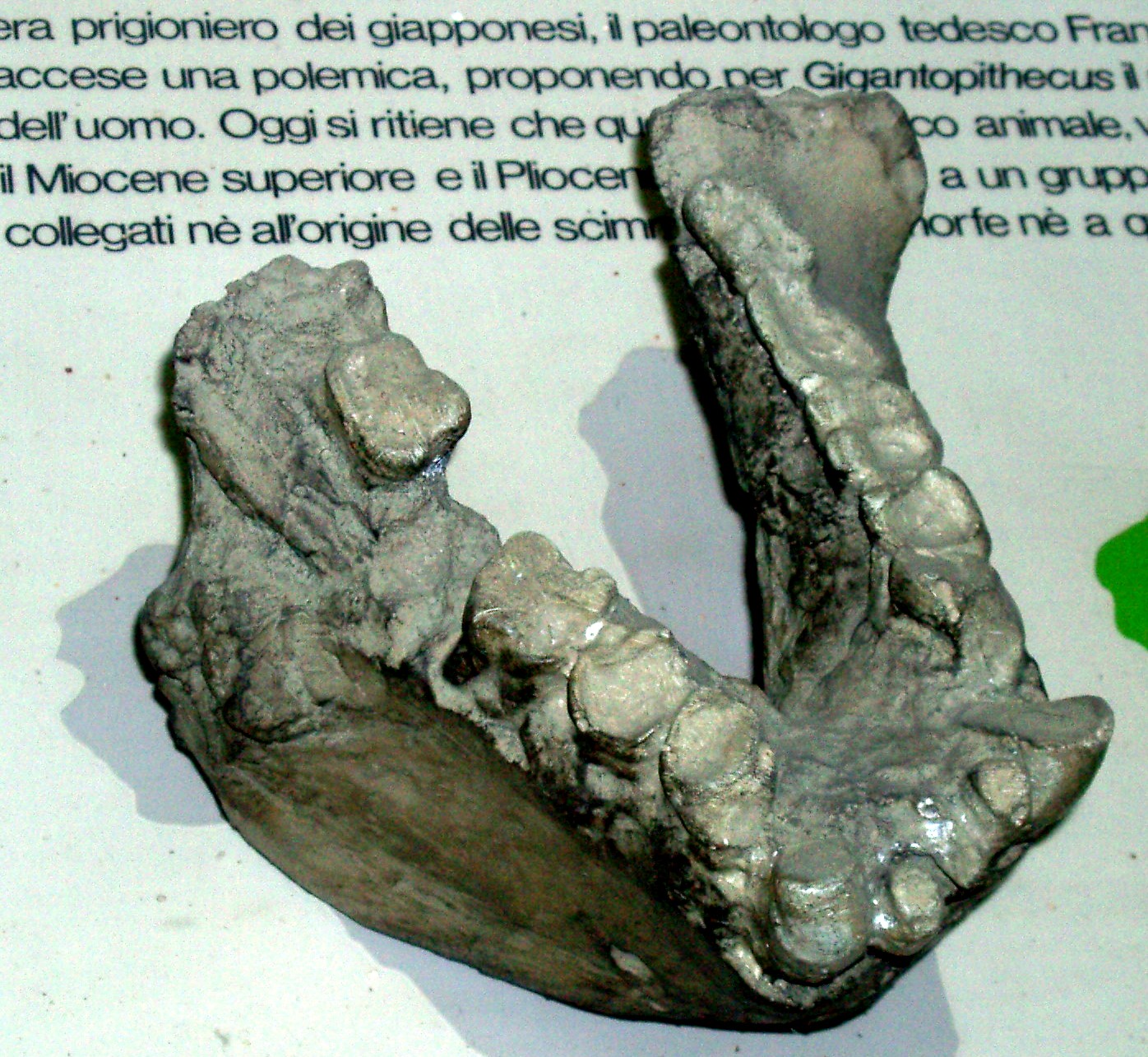
(http://upload.wikimedia.org/wikipedia/commons/0/0d/Gigantopithecus_blacki.JPG)
[Descrição (símio pré-histórico gigantesco cuja existência é reconhecida pela ciência contemporânea:
| "Description |
Gigantopithecus blacki.JPG
English: Fossil of Gigantopithecus blacki, an extinct primate
|
| Date |
2008 - museo di storia naturale di milano
|
| Source |
Own work
|
| Author |
Ghedoghedo".
|
(http://commons.wikimedia.org/wiki/File:Gigantopithecus_blacki.JPG, direitos de imagem: Wikimedia, autorizada a reprodução, sem fins lucrativos, desde que citada a fonte e a propriedade da imagem.)
"(...) Eine Theorie ist, daß die Sichtungen von Bigfoot oder Yeti mit dem fossilen Riesenaffen Gigantopithecus (siehe Abb. 5) zu tun haben. Gigantopithecus blacki, benannt nach dem Kanadier Davidson Black, ist aufgrund von ca. 400 000 Jahre alten Mandibeln beschrieben worden, die an Fundorten in China und Vietnam zu Tage gefördert wurden. Außerdem sind noch mehr als tausend Zähne bekannt, von denen der erste das Licht der wissenschaftlichen Welt erblickte, als G.H.R. von Koenigswald 1935 in Hong Kong einen solchen ‚Drachenzahn‘, die als Heilmittel von chinesischen Apotheken verkauft werden, in einer ebensolchen fand. Nach Analysen, u.a. von Ciochon, sollte dieser Gigantopithecus ca. 3m groß und 600 kg schwer sein. Er ernährte sich nach Angaben von Ciochon hauptsächlich von Bambus, was durch Funde von Phytolithen an den Zähnen bekräftigt wurde. (...)". (http://www.students.uni-mainz.de/meyec012/porta/hausarb/yeti.html)

(http://blog.everythingdinosaur.co.uk/blog/PrehistoricAnimalDrawings/Gigantopithecus/_archives/2007/7/8/3077831.html)
===
Fotos recentes, para comparação entre a altura do grande símio do tempo dos dinossauros e o pé grande, que "existe ou não"


À ESQUERDA, O "GORILA" MUITO ANTIGO CUJA EXISTÊNCIA É ADMITIDA PELA CIÊNCIA OFICIAL
(mais baixo do que seu possível ancestral remotíssimo, percebe-se que o topo do crânio do pé grande [ficcional ou "real", não se sabe, da foto à direita] "bate" talvez um pouco abaixo do queixo do Gigantopithecus):
"'Bill Munns stands next to his model of a Gigantopithecus male, a quadrupedal, fist-walking creature that also could have stood erect, as bears do.'
http://www.freerepublic.com/focus/f-news/1933502/posts
À DIREITA, CERCADO DE AMIGUINHOS ALEGRES, NO disnéico (J. BAUDRILLARD) PARQUE TEMÁTICO, O ANIMAL ATUAL DAS MONTANHAS ROCHOSAS DO CANADÁ E DOS ESTADOS UNIDOS, CUJA EXISTÊNCIA A CIÊNCIA OFICIAL - não se sabe exatamente se de forma precisa ou não... - NÃO RECONHECE, à exceção do caso de um cientista corajosíssimo como o falecido Dr. Krantz, a cuja memória aqui se homenageia, com gratidão. Flávio Bittencourt
===
Notícia sobre tema da ciência veterinária veiculada pela Rev. Época (jan. / 2009)
"Gorila passa por cirurgia rara na Hungria
sex, 16/01/09
por Redação Época |
categoria Sem categoria
Por causa de uma suspeita de câncer no útero, a gorila Liesel, do zoológico de Budapeste, na Hungria, teve de ser operada. Ela tem 32 anos e é a mais velha entre os primatas do parque. Mas depois de dar à luz a três filhotes, Liesel não consegue mais engravidar desde 2000.
A cirurgia durou três horas e nenhum tumor foi encontrado. A gorila foi operada por uma equipe de cirurgiões de um hospital de Budapeste, que foram assistidos pelos veterinários do zoológico. Liesel teve de ser totalmente sedada e vai ser mantida em observação, separada dos outros gorilas, por mais uma semana.
Embora os gorilas tenham uma anatomia muito semelhante à dos humanos, operações nesses animais são extremamente raras no mundo e esta foi a primeira vez que uma ocorreu na Hungria". (http://colunas.epoca.globo.com/animal/2009/01/16/gorila-passa-por-cirurgia-rara-na-hungria/, as duas primeiras fotos a seguir reproduzidas são ilustração da matéria acima transcrita.)


===

MANIPULAÇÃO INFOARTÍSTICA SOBRE DETALHE DE FOTOGRAMA DE FILME
QUE É UMA FRAUDE. OU NÃO É UMA FRAUDE. [Obs.: COR TAMBÉM MANIPULADA:
no filme original, não aparece a cor de pelo dessa "foto"/pintura.] SE O FILME ORIGINAL
TIVER SIDO UMA FRAUDE [ http://fr.wikipedia.org/wiki/Bigfoot_(film,_1967) - clique no link e,
em seguida, digite, depois do algarismo '7', o sinal de 'fecha parênteses'],TEMOS AÍ UM
CASO INTERESSANTÍSSIMO DE trabalho artístico-artificial (SE A EXPRESSÃO NÃO FOR
REDUNDANTE...) EM PRODUTO CULTURAL (fantasia - refiro-me à roupa - recheada de
gente sendofilmada em pleno ato (teatral) performático de caminhada para o mato, em
clareira duma floresta) QUE PER SE JÁ NÃO ERA NATURAL. ISSO SE OS GRANDES
PRIMATAS, AO ANDAREM, ELESPRÓPRIOS NÃO "façam (teatral) pose", AO MENOS
QUANDO UMA "presa afetivo-sexual" ESTEJA PASSEANDO ALI POR PERTO ETC. fb
(http://newsblaze.com/story/20090331111917rocc.nb/topstory.html)






 Grover S. Krantz
Grover S. Krantz













